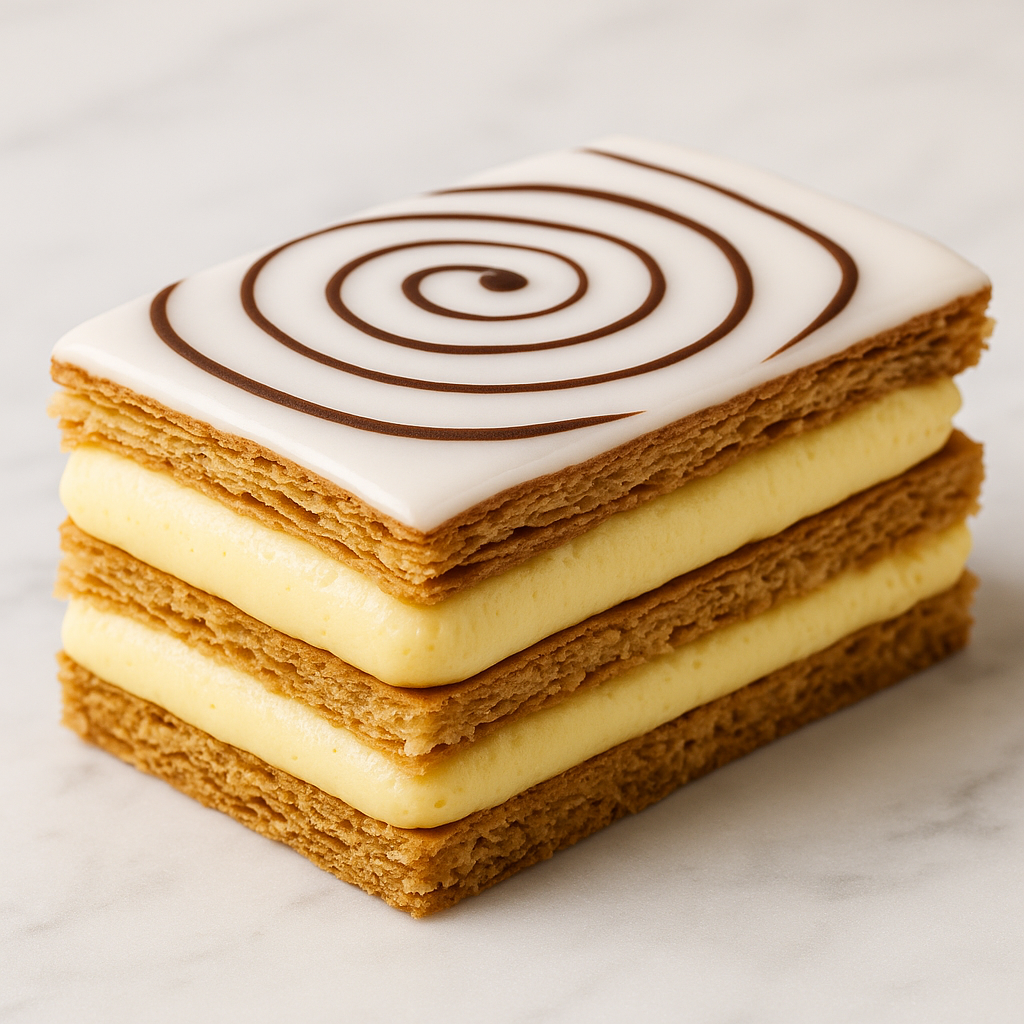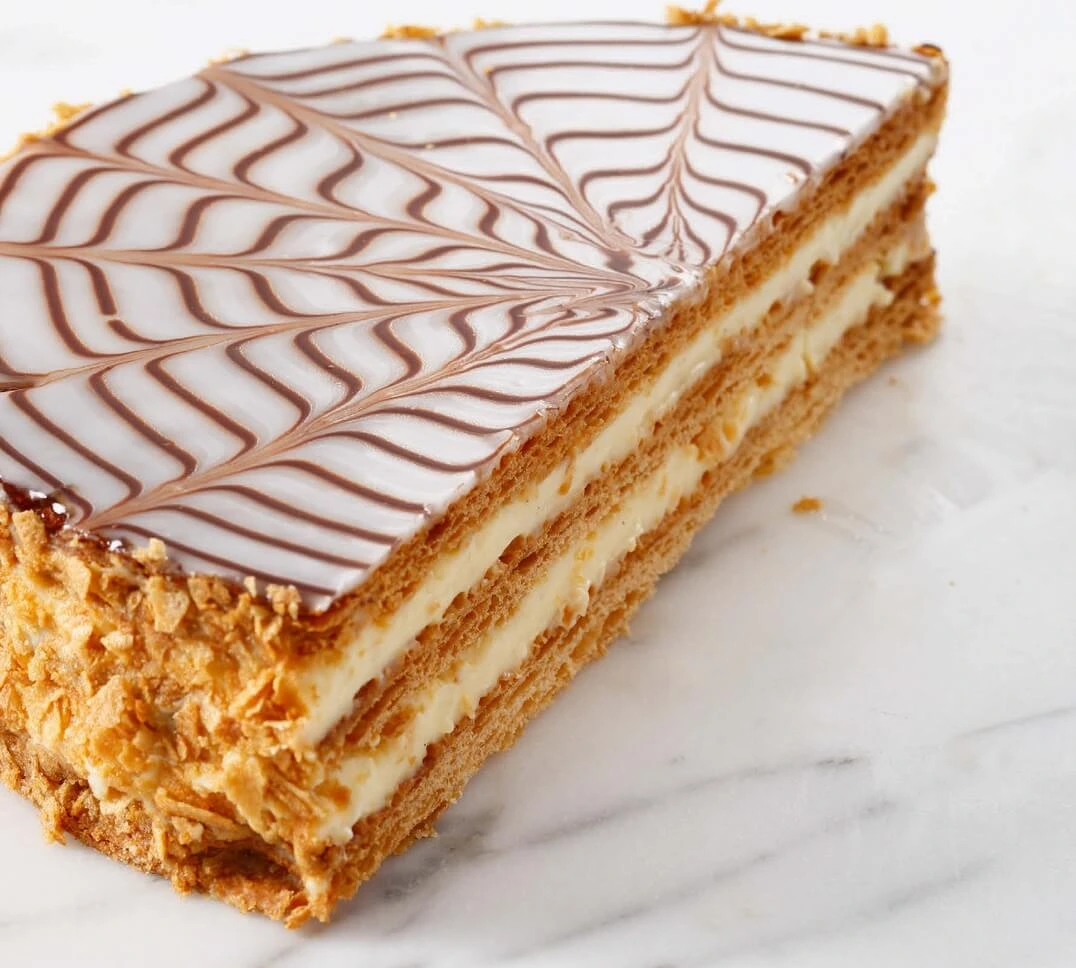The millefeuille, also known as the “Napoleon” in some regions, is a quintessential French pastry renowned for its sophisticated layers and delicate textures. Its name, derived from the French words “mille” (thousand) and “feuille” (leaf), refers to the many thin layers of puff pastry that make up the dessert, creating a visually stunning and texturally complex experience.
At its core, the millefeuille is composed of alternating layers of crispy, flaky pastry and a smooth, rich filling. The top is often glazed with a shiny, elegant icing, sometimes featuring a decorative pattern. The layers of puff pastry, when properly baked, provide a delicate crunch that contrasts beautifully with the creamy interior, making each bite an indulgence in texture.
The preparation of a millefeuille is both an art and a science. The dough must be folded repeatedly, allowing it to puff up perfectly in the oven, achieving the characteristic layers. The filling, typically smooth and velvety, complements the crispness of the pastry, offering a balanced and refined flavor.
A true millefeuille requires precision, as every element must be executed perfectly, from the puff pastry to the filling and the final assembly. The result is a pastry that’s not just delicious but visually impressive, a true centerpiece in any pastry display.
The millefeuille is a symbol of French pastry mastery, often enjoyed during special occasions or as a decadent treat. Its layered structure and combination of textures make it a favorite among pastry enthusiasts, while its delicate flavors continue to captivate palates worldwide. Whether served as a personal indulgence or shared among friends and family, the millefeuille remains an iconic and beloved dessert in the world of pastry.
For 6 to 8 people
Preparation: 4 hours
Chilling: 2 hours 30 minutes
Baking: 50 minutes
Storage: 48 hours
Equipment:
- Rolling pin
- Whisk
- Sieve
- Thermometer
- Piping bag + 15mm round nozzle
- Palette knife
Ingredients
Puff Pastry
- 250g flour
- 5g salt
- 125g water
- 190g butter
Pastry Cream
- 50g sugar
- 250g whole milk
- 1 vanilla pod
- 40g egg yolks
- 15g cornstarch (powdered cream)
- 10g flour
- 25g warm butter
Finishing
- Sufficient amount of white fondant
- Sufficient amount of 66% dark couverture chocolate
- Sufficient amount of feuilletine (crunchy caramelized wafer flakes)
Puff Pastry Method
- On a clean work surface, make a well in the flour. Add the salt dissolved in water in the center and the cold butter cut into cubes. Mix everything well and form the dough into a ball. Refrigerate for 30 minutes.
- Flour your work surface and roll out the dough. Begin the lamination process: perform 1 “portefeuille” fold (folding the dough into thirds) and 1 simple turn (folding it into half). Rest the dough in the refrigerator for 45 minutes.
- Give the dough another “portefeuille” fold and another simple turn. Rest the dough again in the fridge for 45 minutes.
- Roll the dough into 3 discs, each 20 cm in diameter and 5 mm thick. Rest in the refrigerator for 30 minutes.
- Preheat the oven to 220°C (thermostat 7/8) and bake the discs for 10 minutes. Then, reduce the heat to 190°C (thermostat 6/7) and continue baking for about 40 minutes, or until fully cooked through.
- Set the baked puff pastry aside to cool.
Pastry Cream Method
- In a saucepan, heat half of the sugar with the milk and the vanilla pod (split and scraped).
- In a separate bowl (cul-de-poule), whisk the egg yolks with the remaining sugar until pale and creamy. Add the cornstarch and sifted flour, and mix well.
- Once the milk reaches a boil, pour a little of the hot milk into the egg mixture to gently loosen it, then return everything to the saucepan. Cook for about 2 minutes, stirring constantly.
- Once the mixture has thickened, remove from heat and incorporate the butter.
- Transfer the pastry cream onto a tray, cover it with plastic wrap directly on the surface (to prevent a skin from forming), and refrigerate until fully cooled.
Finishing
Prepare your white fondant (you can warm it gently in a bain-marie if needed to make it pourable and glossy). Make a parchment paper piping cone (cornet), and fill it with melted 66% dark couverture chocolate—just enough to pipe with precision.
This is where the millefeuille transforms from pastry to art. The contrast between the pristine white fondant and the dark chocolate allows for elegant decoration: think thin spirals or feathered marbling reminiscent of the classic millefeuille finish. It’s the same attention to visual storytelling you might use in a composed plated dessert—or even when styling a refined brioche tressée for a magazine cover.
Assembly
Using a small paring knife, trim the baked puff pastry into 3 clean discs, each 18 cm in diameter.
- First layer: Place the first puff pastry disc on your serving platter. Using a piping bag fitted with a 15 mm plain tip, pipe half of the chilled pastry cream in a smooth, even spiral or concentric circles.
- Second layer: Gently place the second disc of puff pastry over the cream. Pipe the remaining pastry cream evenly on top.
- Top layer: Finish with the third puff pastry disc, pressing down very lightly to set the layers.
- Glazing: Pour the white fondant over the top of the millefeuille. Smooth it carefully with a palette knife for an even, glossy surface.
- Decoration: With your cornet filled with melted dark chocolate, pipe a spiral starting from the center and working outward. Then, using the tip of a paring knife, draw radial lines from the center to the edge and alternate with lines from the edge inward to create a marbled pattern (classic millefeuille design).
- Final touches: Lightly score the top to indicate portion sizes—just enough to mark the fondant. Remove any excess fondant dripping over the sides, then mask the edges with finely crushed puff pastry trimmings for a clean, professional finish.

Chef’s Tips & Tricks
For a flawless fondant finish:
Before glazing your millefeuille with white fondant, brush the top layer of puff pastry with a very thin coat of neutral hot glaze (also called nappage neutre). This creates a smooth, slightly sticky surface that helps the fondant adhere evenly and shine beautifully once set.
Avoid soggy layers:
Always let your pastry cream cool completely before assembling. Warm cream can cause the puff pastry to soften and lose its crispness.
Clean cuts, every time:
Use a serrated knife dipped in hot water and wiped dry between each slice to avoid dragging the cream and breaking the glaze. This ensures sharp, clean portions.
Want extra crunch?
Dust each baked pastry disc with icing sugar and caramelize under the broiler or with a blowtorch. This adds a delicate crunch and enhances presentation.
Uniformity is key:
Use cake rings or templates to trim your puff pastry discs evenly. A perfectly stacked millefeuille is not only more elegant—it’s easier to serve.
Conclusion
Making a millefeuille at home is an ambitious but immensely rewarding culinary project. It embodies everything that makes French pastry so captivating: precision, patience, and a true celebration of texture. Each element—the crisp and delicately caramelized puff pastry, the silky smooth pastry cream, the glossy fondant topping with its elegant marbled finish—comes together to create a dessert that is both visually striking and delightfully indulgent.
While the process is meticulous, it is also meditative. The care you invest in each fold of the dough, each whisk of the cream, and every final decorative detail is returned tenfold in the finished result. Serving a homemade millefeuille is not just offering a dessert—it’s presenting a symbol of craftsmanship, elegance, and timeless culinary tradition.
Whether you’re preparing it for a special occasion or simply to challenge yourself in the kitchen, a millefeuille is more than a dessert. It’s an experience—a delicious and unforgettable one.
So take your time, follow each step with intention, and above all, enjoy the journey of creating one of the most iconic pastries in the world.
Frequently Asked Questions (FAQ)
Can I make the puff pastry in advance?
Yes! You can prepare the puff pastry dough up to 2 days in advance and keep it refrigerated. You can also freeze it (before or after the final lamination) for up to a month.
Can I use store-bought puff pastry?
Technically yes, but for a true millefeuille experience—with ultra-crisp layers and rich buttery flavor—homemade puff pastry is highly recommended.
What is “fondant blanc” and where can I find it?
Fondant blanc is a white, glossy glaze made from sugar syrup, often used in classic French pastries. You can find it in specialty baking stores, or make it yourself from sugar, glucose, and water.
Can I replace the pastry cream with another filling?
Yes, though it won’t be traditional. Variations include chantilly cream, diplomat cream (a mix of pastry cream and whipped cream), or even fruit compotes for a modern twist.
How long does millefeuille stay crisp?
Ideally, it should be assembled shortly before serving. After a few hours in the fridge, the pastry may begin to soften due to the cream. For best texture, enjoy it within 24 hours of assembly.
What can I use if I don’t have a piping bag?
You can use a zip-top plastic bag with the tip cut off, or spread the cream carefully with an offset spatula. However, for a neat and professional look, a piping bag with a round nozzle is best.

